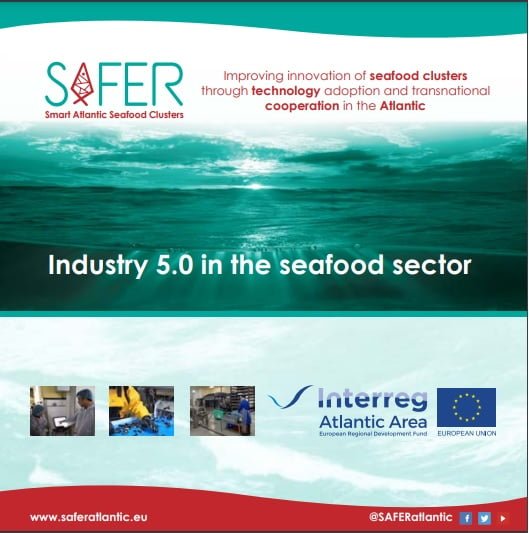
Even though many companies and entire industries are still in the process of the fourth industrial revolution, a new concept is already gaining momentum: Industry 5.0.
Industry 5.0 complements the focus of Industry 4.0 by specifically placing research and innovation in the service of transitioning to a sustainable, human-centered, and resilient industry.
In this regard, the SAFER project (Smart Atlantic Seafood Clusters) published a document explaining what Industry 5.0 is, how it applies to the food sector, and specifically to the fish and seafood sector.
What is Industry 5.0?
According to the European Union, Industry 5.0 “provides a vision of the industry that goes beyond efficiency and productivity as the sole objectives, reinforcing the role and contribution of the industry to society” and “places worker well-being at the center of the production process and uses new technologies to provide prosperity beyond employment and growth, while respecting the planet’s production limits.”
In summary, Industry 5.0 reflects a shift from a focus on economic value to a focus on social value, as well as a shift from well-being to personal satisfaction with one’s way of life.
Why is Industry 5.0 significant for the fishing and aquaculture industries?
Industry 5.0 will be essential for rapidly changing the landscape of innovation, societal demands, and challenges such as pressure on natural resources, ecosystems, global warming, and population growth.
In this sense, implementing a robust innovation plan can start with identifying the appropriate technologies for specific seafood products and making changes in the industrial paradigm for fully inclusive value chains.
Stay Always Informed
Join our communities to instantly receive the most important news, reports, and analysis from the aquaculture industry.
Pillars of Industry 5.0
The authors of the document make some proposals for the fish and seafood industry based on the three key pillars established by the European Commission for Industry 5.0.
Human-centered strategy
A human-centered strategy is one that “promotes talent, diversity, and empowerment.”
The most important change is to shift from seeing people as a means to seeing people as the end. In other words, it involves a change in perspective from people serving organizations to organizations serving people.
Instead of taking emerging technology as a starting point and examining its potential to increase efficiency, a human-centered approach places the needs and interests of humans at the center of the production process.
In summary, instead of asking what we can do with new technology, we should ask what technology can do for us.
In this section, the document discusses the new role for workers in the industry, safe and inclusive work environments, and skills and professional upgrading.
Resilient Strategy
Resilience refers to the need to develop a high degree of robustness in industrial production to face disruptions and ensure the ability to provide and sustain critical infrastructure in times of crisis.
Blue food systems are a network of formal and informal producers and distributors, retailers, and consumers. Some supply chains, market segments, companies, smaller-scale actors, and civil society have shown signs of greater resilience than others.
Sustainable Strategy
A sustainable strategy involves taking action on sustainability and respecting the limits of the planet.
In this sense, it is necessary to develop circular processes that reuse, repurpose, and recycle natural resources, reduce waste, and environmental impacts.
Sustainability leads to reducing energy consumption and greenhouse gas emissions to prevent the degradation and depletion of natural resources.
Technologies such as artificial intelligence and additive manufacturing can play important roles by optimizing the efficient use of resources and minimizing waste.
Conclusion
While the concept of Industry 5.0 is gaining traction, many companies are still engaged in Industry 4.0 or its preliminary versions.
“However, the fact that the EU is pushing companies to the next level and building its Industry 5.0 framework on these three pillars provides the seafood sector with a vision of what true progress will mean in the coming years,” concludes the document.
Reference (open access)
SAFER. 2023. Industry 5.0 in the seafood sector. 8 p.
Editor at the digital magazine AquaHoy. He holds a degree in Aquaculture Biology from the National University of Santa (UNS) and a Master’s degree in Science and Innovation Management from the Polytechnic University of Valencia, with postgraduate diplomas in Business Innovation and Innovation Management. He possesses extensive experience in the aquaculture and fisheries sector, having led the Fisheries Innovation Unit of the National Program for Innovation in Fisheries and Aquaculture (PNIPA). He has served as a senior consultant in technology watch, an innovation project formulator and advisor, and a lecturer at UNS. He is a member of the Peruvian College of Biologists and was recognized by the World Aquaculture Society (WAS) in 2016 for his contribution to aquaculture.




